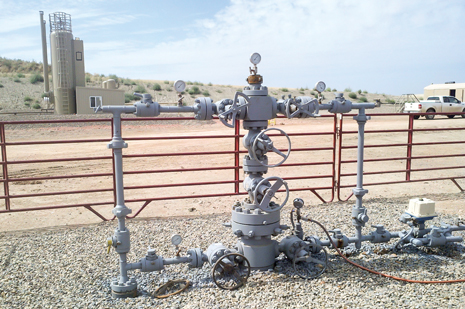 |
| A Liberty Resources production site in the Bakken shale play. |
|
The continued global demand for oil and gas compels operators to keep searching for new means of boosting production from their wells. Whether a field has been in production for only a few months, or several decades, maximizing production, typically, means employing one of several artificial lift methods.
While a wide variety of well-established artificial lift methods exists—sucker-rod pumping, electrical submersible pumping (ESPs) and gas lift are but a few—the choice of which type to deploy depends on several factors, including the remaining production potential of the field, operating costs, and the level of complexity with a given system. In many onshore regions, such as the Bakken shale in the U.S., the choice often boils down to cost and confidence, with well-established methods winning the vast majority of the work.
Liberty Resources has, however, taken a different approach to selecting an artificial lift solution for its oil wells in the Bakken, focusing on a less-established system that helps the company’s wells reach their full production potential. Liberty’s Bakken oil wells share a similar profile, consisting of 10,000-ft vertical sections and 10,000-ft laterals and, on average, 35 frac stages per well. These stages are stimulated, using a plug-and-perf method, versus sliding sleeve technology, and with fracturing fluids composed of 100% slickwater and a ceramic proppant.
Like many shale operators in the Bakken and elsewhere, Liberty experienced high initial production (IP) rates from these wells, ranging from 1,500 to 4,500 barrels of fluid per day (bfpd). However, these rates are not sustainable for long, and, within the span of three to nine months, a well’s production rate may drop off quickly to one-sixth of its initial rate. This steep production decline means that operators have to be ready with some type of artificial lift solution within months of a well’s first production.
Rod pumping represents, perhaps, the most-established, well-understood artificial lift method in North America’s onshore market. The vast majority of artificial lift wells under production in the Bakken employ rod pumping, largely due to the institutional knowledge and reliability of the system.
However, these systems suffer from operational challenges that limit their ability to help a well reach its full production potential. The advent of long laterals, and many frac stages per lateral, places unique demands on any artificial lift system—demands that change too quickly for sucker rods to keep pace with. The typical production profile for a shale well follows a trend of rapid decline from IP rates in the first year or two, followed by a more gradual production decrease through later years, Fig. 1.
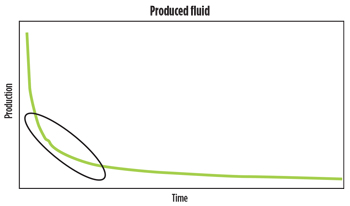 |
| Fig. 1. A representative production decline curve for a shale well. Operators are challenged with finding the best artificial lift solution that will adequately handle the transition between the steep and plateau sections of the decline curve, in a way that optimizes production. |
|
In general, rod-pump systems are not designed to optimize production during rapid rate decline. Rod-pumped wells may have a fluid-over-pump level of between 3,000 ft and 5,000 ft for sustained periods, during the early production stages of Bakken wells. This scenario leaves a great deal of production in the well, at any given time, and a tremendous amount of cash flow downhole.
The option of simply using a larger rod pump to lift more fluids out of the well is not possible for the operator’s field applications, which include ambient downhole temperatures as high as 250°F, and highly brackish formation water, with a density of roughly 10 lbm/gal and chloride content of 120,000 ppm. These conditions place a great deal of stress on rod pump systems, which are challenged with trying to lift a high-density fluid up a 10,000-ft vertical section to surface, at rates sufficient enough to pump off the well.
The continual up-and-down movement of the sucker rods in these challenging wellbore environments, typically leads to fatigue failure scenarios, increasing the frequency of workovers to replace pumps, rods and tubing. This problem is further compounded by the heavy-brine formation water, which deposits substantial quantities of salt and scale on the tubulars and sucker rods, further shortening the time between interventions. Early in a well’s rod lift application, up to four workovers per year can be required, at an average cost of $100,000 per workover. The operator was eager for a less-costly artificial lift solution, with increased production results.
JET PUMP POTENTIAL
A number of other artificial lift options, such as ESPs and gas lift, can move fluid out of the wellbore more effectively than sucker rods. However, these methods have their limitations. ESPs are prone to limited operability, or outright failure, if exposed to solids or gas. Gas lift methods are, typically, not suitable for early-stage production, because newer fields, or single-well pads, may not produce sufficient volumes of the gas required.
This prompted Liberty to investigate the feasibility of using hydraulic jet pumps, for artificial lift needs, in the early production stages of various wells. This method works by pumping power fluid—typically oil or water produced from the reservoir—down the tubing, via a surface triplex pump. The fluid then travels through the downhole jet pump, which is equipped with a nozzle-throat Venturi combination. The fluid travels through this nozzle, creating a low-pressure Venturi effect at the discharge of the nozzle. This low pressure allows the produced fluid to enter the jet pump. The produced fluid and power fluid both enter the throat, where they are mixed together. The mixed flow then goes to the diffuser, where sufficient static pressure is recovered, such that the combined fluids can be lifted to the surface, Fig. 2.
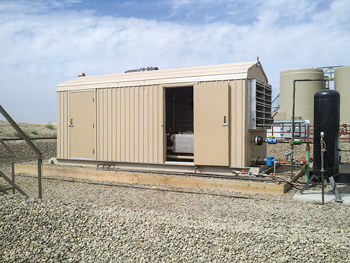 |
| Fig. 2. A jet pump building in the Bakken shale (image courtesy of Liberty Resources). |
|
Like other hydraulic systems, such as reciprocating piston pumps or downhole turbines, jet pumps work effectively in both shallow and deep wells (well depth ranges of 500 ft to 20,000 ft are not uncommon). They also have a wide operating range, in terms of flowrate, working reliably in wells producing as little as tens of bfpd to more than 35,000 bfpd. These pumps have no downhole moving parts (i.e. no mechanical wear), and allow for more effective and efficient addition of freshwater and production chemical treatments into the wellbore.
Because of these benefits, jet pump usage is expanding beyond production operations. They are finding increased acceptance for frac flowback operations, to remove frac fluids, proppant and fractured formation rock from the newly created fracture network.
When installed and operated properly, jet pumps efficiently optimize production during early well life, thus improving well economics at an operating cost comparable to other forms of lift. The pumps are then, sometimes, but not always, replaced with other lift technologies.
Operators will be able to effectively “walk down” the production decline curve, as seen in Fig. 1, and more closely match the well’s true production capability. To periodically resize the throat and nozzle combination, a jet pump is easily cycled out of the well. The modified pump can then be cycled back down the well, with a configuration that optimizes well deliverability, in short periods of time, without the need for an intervention or a different artificial lift mechanism.
Once IP rates have dropped and steadied into a plateau phase, there is less economic incentive to continue fine-tuning the artificial lift system to optimize production. The operator may then decide to transition to a rod-pump system with smaller units, which are more than adequate to handle ongoing production declines at a cost-effective price point.
READY FOR THE FIELD
Liberty worked with the service provider to field-trial jet pumps in 14 Bakken oil wells, beginning in mid-2012. Initially, each well followed the same general installation and operational protocols. Once all stages in the lateral were stimulated, and the frac plugs were drilled out, the initial completion hardware was run in-hole, consisting of an 18-ft seal assembly with two bonded seals to land in the polished bore receptacle of the liner top packer. This hardware also consisted of a crossover, a standing valve seat nipple and WXO sliding sleeve.
After the completion assembly was set, the well was produced under natural reservoir pressure, until loading occurred. At this point, the well was placed on jet-pump lift by first rigging up and deploying slickline to open the sliding sleeve, dropping a standing valve and, finally, dropping the jet pump downhole and activating it.
During the initial installations, the operator and Weatherford discovered some challenges with the jet pump deployment that prevented the artificial lift system from operating at its optimal potential. These issues included a 50% success rate in opening the sliding sleeves, due to the presence of debris in the annulus, and a misalignment of the jet pump discharge ports with the sliding sleeve holes. Additional challenges arose from a hole in the tubing above the pump caused by erosional wear; solids in the power fluid (which was not filtered) that caused plugging of the nozzle; and well slugging that yielded large pressure swings at the pump.
Solutions included snubbing into the tubing open-ended and producing until well output declined, and pulling the tubing to install a standard, ported subJet Pump BHA, in place of the sliding sleeve. A heavy-wall tubing sub and blast joint were installed above the ported sub, and inline filters were installed on the surface pump discharge. Finally, a 23/8-in. dip-tube was run into the curve to an inclination of approximately 55°.
These solutions were in place by the ninth installation, thus ensuring that all subsequent jet-pumped wells were brought online with minimal running and tripping time. The majority of the first nine wells were also worked over, to change their BHAs to the new design. After the workovers, each well demonstrated measurable and sustained production increases over previous assemblies. Upon pulling and inspecting the tubulars, little-to-no salt or scale was observed.
COMPARING RESULTS
To gain a better understanding of just how much additional production uplift was achieved with the jet pumps over the sucker rod systems, Liberty Resources conducted a type-curve analysis. Type curves, which plot cumulative oil production (y-axis) against cumulative producing days (x-axis), were plotted for each of the 68 wells. A mathematical average type curve of all 68 wells was then obtained, with an initial (30-day) production rate of 925 bopd, a b factor of 1.57, an initial decline of 80% and an exponential tail of 6.5%, Fig. 3.
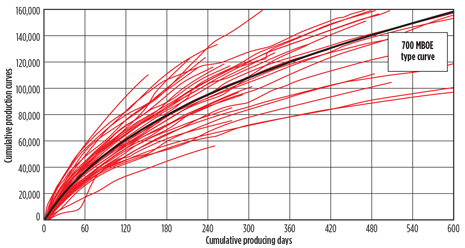 |
| Fig. 3. Individual cumulative production curves for each of the 68 rod-pumped wells (red curves) in one of Liberty’s Bakken assets. A type curve (in black) represents the mathematical average of the individual production curves. |
|
The analysis continues by comparing the cumulative production of wells on jet pumps to the shape of type curves obtained by adjusting the 30-day IP rates, keeping the other parameters the same. Figure 4 shows such a comparison for five jet pump wells versus the type curves generated, if these same wells had been run on rod pump. In each case, the jet pump wells exhibit an incremental oil production improvement above their type curves, ranging from 7,700 bbl to more than 17,000 bbl of additional oil produced.
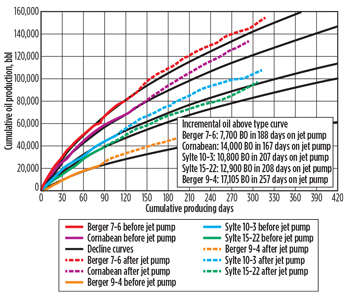 |
| Fig. 4. A comparison of five jet-pumped wells with their type curve counterparts (grey curves), which represent the expected production, if the wells had been on rod pump. Once jet pumping commences, each well experiences an incremental increase in its production rate over the expected rod pump rate (dashed curves). |
|
Of the 14 wells placed on jet pump to date, 10 have generated sufficient data to compare the base production levels to the incremental uplift. Liberty recorded a first-year incremental cash flow improvement of approximately $850,000 per well, by implementing jet pumps instead of rod pumps. This is a net value, assuming a 100% working interest, and 80% revenue interest for the company and $95/bbl oil. Due to further refinements in the installation and operation of these jet pump systems, the operator expects the systems to achieve an incremental revenue increase of $900,000 per well in the second year.
FINE-TUNING OTHER FUNCTIONS
The use of jet pumps provides additional operational benefits, beyond improving a well’s production capacity. Due to the high brine content of the produced water, these wells are treated daily, with up to 50 bbl of fresh water to dilute the salt and reduce the risk of salt and scale deposition downhole. In a jet-pumped well, this water can be added downhole easily, by mixing it at the surface with the fluid used to power the pump. Contrast this to a rod-pump scenario, which requires adding 50 bbl of fresh water down the backside of the tubing, and hoping that it will mix efficiently with the produced fluids downhole. Because many rod-pump wells contain 3,000 ft to 5,000 ft of produced water sitting above the pump, the fresh water is more likely to sit on top of the fluid column, rather than mixing with it to dilute the salt content.
Jet pumps offer a similar mixing efficiency in the downhole addition of production treatment chemicals, as treatment formulations, such as corrosion inhibitor, biocide and oxygen scavenger, can be pumped downhole and into the jet pump with the power fluid. One can easily verify that the right amount of treatment chemical has been introduced, or if changes to the injection rate are required, by analyzing fluid samples pulled from the separators. In rod-pumped wells, these chemicals are slowly introduced down the backside of the tubing from the surface.
Liberty is also investigating the feasibility of using jet pumps to counteract the effect of slug flow that arises from the porpoising of the 2-mi-long lateral sections in these wells. The buildup of fluids at the low points of the porpoising wellbore results in wide variations in water cut, gas-to-liquids ratios, and, ultimately, the intake pressure at the pump, Fig. 5.
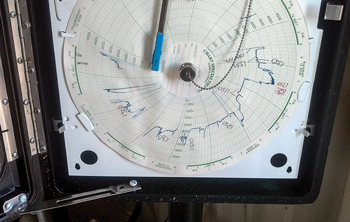 |
| Fig. 5. Porpoising of the long lateral sections in Liberty’s wells creates slugs of gas and water that periodically enter the pump, which causes variations in pump pressure discharge of up to 2,000 psi. |
|
Overcoming this problem in the past meant running the pumps at a much lower rate, which translated to a lower-than-possible production rate. This problem can be remedied by linking the surface pumping system to a process logic control (PLC) system. The PLC system programs the injection pump to run at a constant pressure, rather than a constant rate, which is the typical means of running this lifting method.
Instead of pumping at a safety margin of 50% of pump capacity, to avoid wide swings in BHP, the PLC would allow the pump to run at 90% or greater of its capacity, while maintaining a constant pressure by making real-time adjustments to the pump rate. By running the pump closer to its potential, without fear of large and potentially damaging pressure swings, the well should experience higher production rates and increased cumulative output.
The service provider has run jet pump units with PLC systems in North American wells to address this specific issue. The solution has significantly decreased downtime, due to the high/low-pressure discharge kills, thereby reducing non-productive time while simultaneously increasing production rates.
While all installations to date have been in individual wells, Liberty envisions employing a larger surface pump system to lift multiple wells on a pad for greater CAPEX savings. 
|








